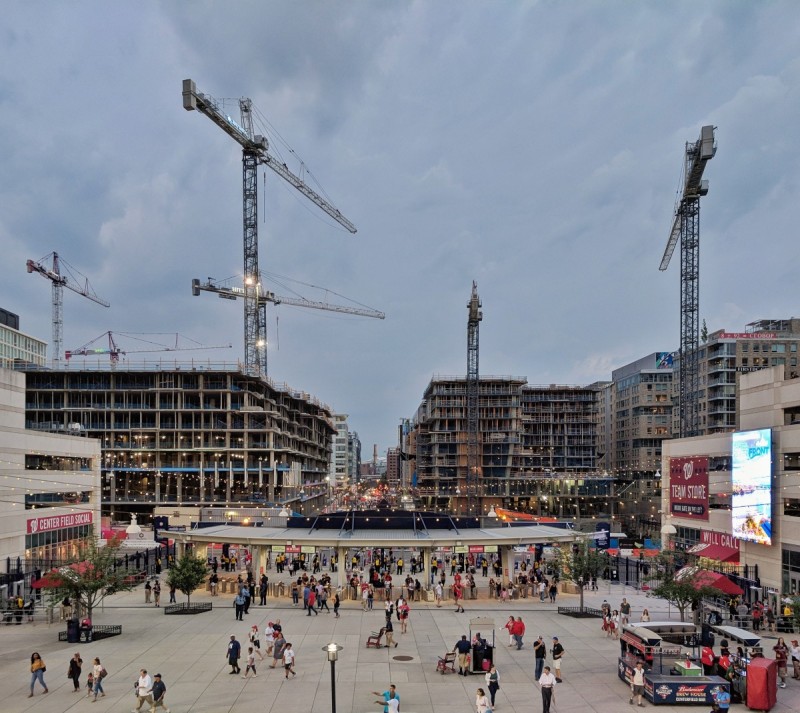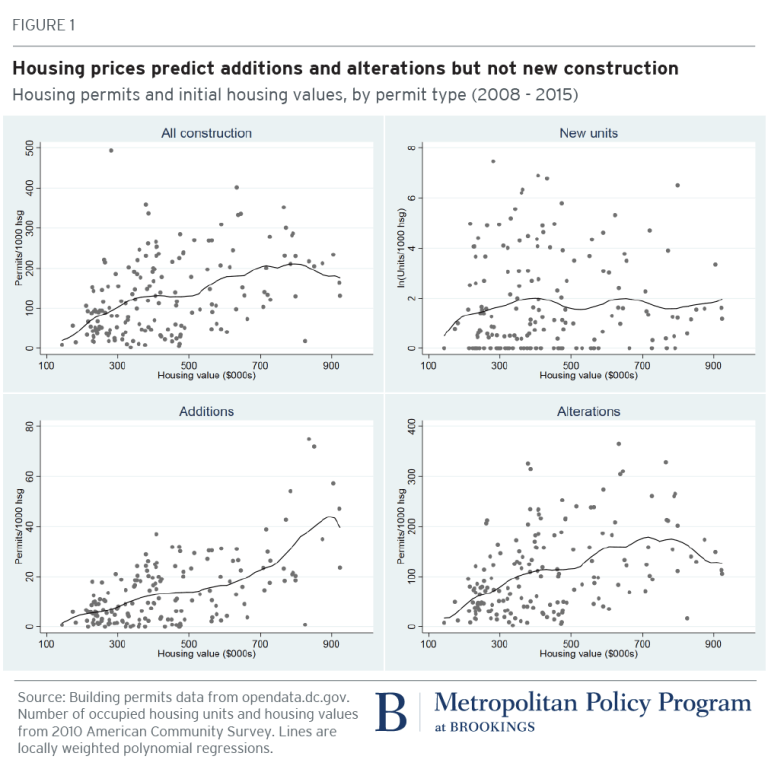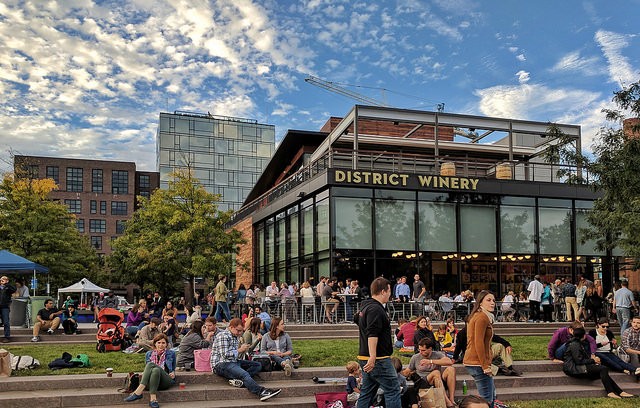A tale of two 20003s: high rises or high rents

Cranes along Half St. SE, May 2018 by the author.
The near southeast quadrant of the District, from the Capitol dome down to the banks of the Anacostia river, has one ZIP code split in half by I-695, better known as the Southeast Freeway. Although these two areas look incredibly different at first glance, upon closer inspection they form a curious natural experiment.
One has seen frantic new housing construction, while the other has not. One has seen dramatic rent increases, and the other has not. Which one was the cause, and which the effect?
The law of conservation of buildings
Seward Square in 2007 by the author.
North of I-695 is Capitol Hill, where one of the country's largest, oldest, and most fiercely-guarded historic districts has steadfastly maintained the neighborhood's physical character. The streets of colorful, low-rise rowhouses look much the same as they did 25, or even 125, years ago.
Proposals to build new buildings — even for something as uncontroversial as a supermarket and mid-rise, mixed-income apartments adjacent to Metro — must undergo a gauntlet of reviews, lawsuits, and counter-lawsuits that can drag out for several years and cost millions of dollars. The process is so daunting that hardly anyone even bothers trying, and so few new housing units have been built in recent years.
In fact, according to a recent Brookings analysis by Jenny Schuetz, four Metro-adjacent Census tracts in the area saw essentially no new housing units built between 2008 and 2015.
High-rise luxury condo boomtown
South of I-695 is Capitol Riverfront, or “Nats Flats” as City Paper once called it, where seemingly everything is shiny, new, expensive, and filled with yuppies having fun. In just the past five years, the Capitol Riverfront's streets have been rendered nearly unrecognizable by a startling metamorphosis: this boomtown has seen a dozen luxury residential towers open their doors, almost half of all new homes built in DC.
The neighborhood has more than doubled in in size, going from 3,000 to 6,200 housing units, and services have also blossomed, with the local restaurant count going from 20 to 52. The dozen tower cranes looming overhead herald even greater change to come.
Where are rents skyrocketing?
So, which neighborhood has seen rents skyrocket over the past five years: the “instant neighborhood” of glitzy high-rises, or the stodgy, drafty old rowhouses?
Apartment rents in Capitol Hill and Capitol Riverfront, as tracked by Zillow, 2013-2018. Image by the author.
According to Zillow, rents in Capitol Hill have increased by almost 20% in the past five years — substantially faster than overall inflation, which has increased by 7%. Meanwhile, rents in the Capitol Riverfront have fallen slightly by about 8%, staying at levels which are (by the official definitions) affordable at the area median income. Not long ago, shiny new high-rise apartments around Navy Yard rented for more than the old rowhouses on the Hill. Now that many shiny high-rises have been built, they've become the cheaper option despite their “luxury amenities.”
Even as thousands of new residents have poured into Capitol Riverfront (most of whom aren't exactly rich), thousands of new apartments have opened. Those new residents can just move into new buildings instead of bidding against existing residents for existing apartments. Current residents report that landlords are eager to cut deals on lease renewals to keep residents from decamping to even newer, glossier buildings.
By contrast, people who want to move to the Hill, or even just move to a different apartment on the Hill, must compete for just a few empty apartments. As a result, prices are bid up. (Zillow's estimates skew towards the higher end of available rentals. It mostly draws upon units listed for rent, but its statistical model also takes into account the broader mix of units.)
Turns out both neighborhoods have seen lots of construction
Stopping new apartments from going up didn't stop the rent from going up in Capitol Hill. Indeed, it didn't even stop new construction: instead of new apartments, large and breathtakingly expensive new homes went up within the immaculately retouched shells of the old homes.
A rowhouse under renovation in DC. Image by Bonnie Bogle licensed under Creative Commons.
Schuetz's report on building permits found very few new units built on the Hill — but did find plenty of new construction. Instead of tower cranes building hundreds of new homes at a time, the Hill (and other neighborhoods like it, like Takoma) saw hundreds of renovations and additions that transformed inexpensive old houses into luxury showplaces.
The number of units and overall population remains stable, even while housing prices surge: the median price of Hill houses has increased 59% since just 2010, and over one-fourth of units sold for over $1 million. Even as the “neighborhood character” of historic rowhouses has stood still, the neighborhood's population and social character have been transformed as ever-higher housing prices exclude all but the wealthy.
As Dan Reed recently pointed out about Bethesda, “keeping our neighborhoods insulated from change has real costs — as in, they become enclaves for the wealthy.” The same process has played out in Adams Morgan, where steadily rising demand for a static number of homes has resulted in a situation that scholars have called “advanced exclusion.”
New construction happens only where values are high
New construction, on its own, doesn't cause higher rents. Instead, the causal direction runs the other way: high rents enable new construction, since new construction is expensive. (Practically anything is more expensive new than used, and that includes buildings.)
Sure enough, Brookings found a positive relationship between housing prices and construction permits in DC. As the upper-left graph shows, more construction permits were issued in DC census tracts with higher housing values, but as the upper-right graph shows, those permits weren't usually for new homes.
See top left graph for relationship between housing prices and construction permits. Data analysis by Jenny Schuetz. 
That new construction will occur in whatever form that zoning allows. Where zoning allows apartments, apartments will get built. Where zoning only allows single-family houses, single-family houses will get built — just ever-larger and more elaborate.
The causal direction gets complicated
Since higher property prices are often accompanied by new construction, many people see shiny new buildings or fancy new shops and blame the new things for the neighborhood change. After all, changes to a neighborhood's buildings are easy to see, while changes to the people in the buildings are more subtle. Yet that approach focuses on symbols, rather than substance, and often mistakes cause for effect.
Yards Park and District Winery by the author.
Miriam Zuk, director of Berkeley's Urban Displacement Project, tells On Common Ground that “places where development is happening [are] where rents are rising. People are already feeling the squeeze, and when they see new housing, it's the most visible and tangible thing to grab onto.”
The relationship between supply, demand, and construction is indeed complicated by a feedback loop: amenities, particularly service businesses and conveniences. As local economist Lyman Stone tweeted, “At the very local level, greater density yields greater incentive for businesses to locate in the area, and raises amenity values.”
For instance, the many more residents around Capitol Riverfront enticed more restaurants and shops to open in the neighborhood, which in turn made the area more attractive to even more new residents.
This feedback loop is why many urban planners and economists point out that the principle of more housing supply lowering rents doesn't necessarily apply at the neighborhood level. Rick Jacobus, a housing advocate, writes in Shelterforce that “New development may lower prices regionally even while it raises prices in a specific neighborhood.”
This “induced demand” phenomenon more readily occurs with highways than with housing. A large number of individuals can easily consume additional road space, just by driving faster and farther for a few more minutes apiece. Yet moving house is different than driving: moving is a tremendous chore, so a much smaller number of households would have to consume much more housing in order to absorb the newly built space.
Prices can stabilize, given enough units, but won't drop far
Jacobus continues: “In established neighborhoods, no matter how much building is going on, the new supply will be small relative to the overall market so increased supply will have almost no impact on rents.”
Yet aside from the Capper-Carrollsburg housing project, which has been under redevelopment ever since its demolition was announced in 2001, much of Capitol Riverfront had very low building densities despite its central location. Its experience shows that it does appear to be possible, given an incredibly high number of new houses, to completely satisfy the demand for new homes — even after accounting for induced demand.
“If you build more housing in a neighborhood, you can accommodate more people, and demographic change is likely to be slower. If you don’t build housing, you make neighborhood change a zero-sum game, and likely accelerate displacement,” writes Joe Cortright about how Fruitvale, a multiethnic neighborhood in Oakland, may have mitigated displacement by expanding onto adjacent industrial land. (A similar tale can be told of Chicago's Chinatown.)
Yet don't look for prices in Capitol Riverfront to completely collapse anytime soon. New high-rises are inherently expensive to build, so if prices fall below construction costs (“replacement cost” in the industry, or “marginal cost of production” in economics textbooks), construction will pause.
The rest of DC looks more like the Hill than the Flats
Schuetz finds that the Hill's combination of high housing values and lots of renovations and additions, but few new units, is a common one across DC's wealthier western neighborhoods, almost all of which have banned apartments in the name of “neighborhood stability.”
These widespread apartment bans have pushed population growth elsewhere, Schuetz writes: “when developers can’t build luxury housing in affluent neighborhoods, the pent-up demand for high-end homes will spill over into nearby middle-income neighborhoods.”
A small apartment building neighboring Tudor Place in Georgetown. Image by the author.
Since the average DC neighborhood is more like slow-growth Capitol Hill than boomtown Capitol Riverfront, Zillow's rent graph shows DC-wide rents tracking the Hill's steady rise upwards rather than the Flats' plateau.
The good news is that almost every neighborhood, both in DC and elsewhere, can add lots of new homes even without costly new high-rises, whether through accessory dwelling units, townhouses and duplexes and fourplexes, or converting and infilling commercial sites. Undoing laws that prize “neighborhood stability” over affordability and inclusion would be a great start in making sure rents decline in more neighborhoods than one.
